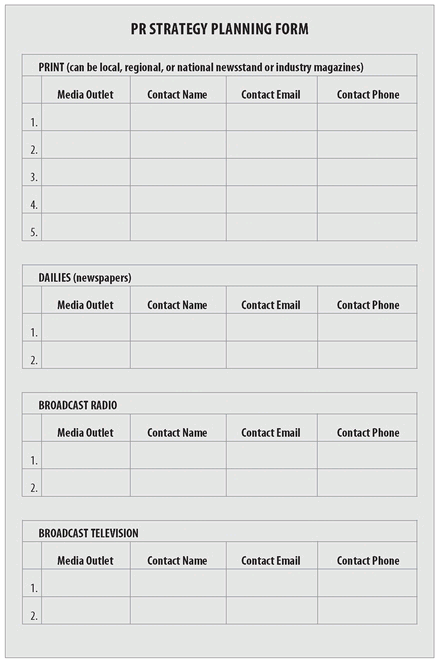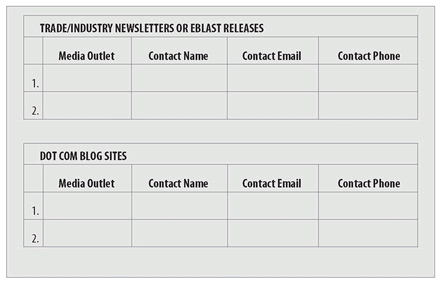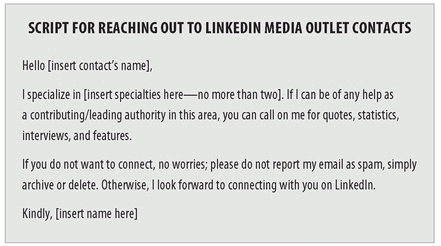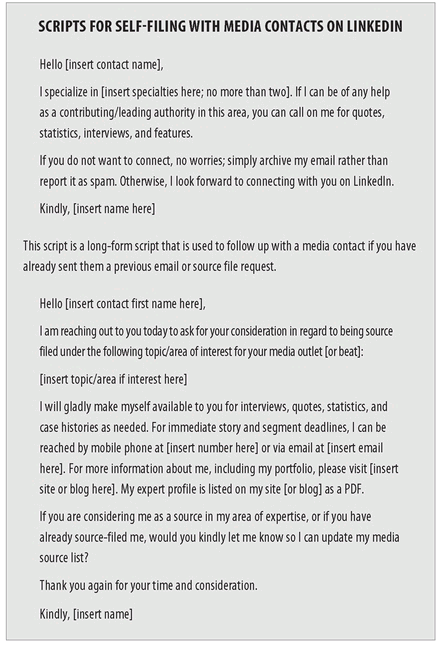12
THE TIDAL WAVE APPROACH
social networking for powerful publicity
If a picture is worth a thousand words, then an article must be worth a thousand ads.
—UNKNOWN
Public relations tools are the most powerful in building your brand. Business startups often need to build their credibility quickly to compete with established competition. By taking advantage of public relations opportunities you can position yourself as an expert in your field, attract media attention, and serve as a quoted source in published articles. As you give interviews and get quoted, professional associations may ask you to give speeches or participate in panel discussions, thus solidifying your credibility.
Why PR works
Emerging-growth entrepreneurs will tell you that it’s not enough to win a new customer. You need to convince a newcomer to come back and buy more. By aligning your PR campaign with your goal of attracting repeat business, you can build consumer confidence and trust. For example: By prequalifying some of your best customers on your website, you send a message that you value your clients and share a stake in their success. Also by targeting a group of potential buyers, you can build visibility and thus grow your client base. Each time people read your company name and associate it with something positive, it will reinforce their awareness of your brand and help them differentiate your company from your competitor. And last, but not least, PR is excellent for when you enter a new market or launch a new product or service, and you need to alert potential buyers that you’re open for business. Effective PR can draw them in and educate them about what you offer.
Building your online media list
The first thing that you want to do when building a PR campaign is make a list of the most desired media outlets that you would like your company or product to be featured in. You should have a list of about 15 media outlets to start with.
Determine the best media outlet contacts
Once you have compiled your list, you need to determine who the best contact is. Here are the best places to start your search:
• Check the masthead, usually on the inside front cover, or on the second page, of each magazine for its list of editors for specific segments of the publication. Which one most closely fits your company? If you are unsure, the managing editor is a great place to start.
• For television news, you want the assignment desk editor
• For daytime shows, you want a segment producer
• For radio, you want the show producer.
Next, you need to gather contact information: contact name, phone and fax numbers, and email address for each outlet. Use the form provided in
Figure 12.1 to organize your information.
Preparing for contact
Now that you have created your list to include contact information, do a little research on each editor or producer. Watch a few minutes of the television show, listen to the radio show, or read one of the editor’s articles to get a feel for who you will be talking to and their work.
Another way to prepare is to call the media outlet, and say, “I am hoping that you can help me. I am in the [insert industry here] industry, and I am looking for the name of the person that would cover that beat.” (“Beat,” in the media world, means “topic,” or “subject of interest.”) Avoid giving your company’s name to the receptionist because they will send you to the advertising department rather than the editor!
Another great way to build relationships with the media is to send out a quick email to your centers of influence—family and friends—and tell them about your plan to build a PR campaign. Ask them if they happen to know anyone at any of these outlets. Your friends and family know more key people than you can imagine!
Continue to add to your list as you find new media outlets, and update your list every 90 days with the most current contact information. A media list gone stale results in zero coverage for your company.
Make sure that you focus on adding the key decision-makers at each outlet to your list. LinkedIn is a great resource for finding professional journalists and segment producers that are high-level, make-it-happen people. With LinkedIn’s new search features, you can dive deeper into user data to find contacts that fit your criteria. For example, you can create a search to find contacts with “reporter” as their professional title within a 50-mile radius of your zip code, but if you live in a metropolitan area, your search may result in more than 15,000 contacts. You can easily narrow this search by limiting other fields or adding a keyword like “business” or “features.” LinkedIn also lets you save five searches, so you can be alerted to new contacts that join LinkedIn matching your criteria. When searching for media contacts, be sure to add in keywords to locate decision-makers at each media outlet. Some keywords you might use for print media outlets are managing editor or staff writer. For broadcast media, keywords to search for decision-makers would be segment producer or assignment editor. Avoid titles like “associate,” “columnist,” or “contributor,” as these are not likely decision-makers.
Call the media within seven days after sending them a pitch, use this approach to get that feature or something along those lines.
Launching into media contacts
Once your list is complete, get to know the search options and connect with these top media decision-makers on your list.
Connecting with the media on LinkedIn
Figure 12.2 on page 172 contains another script for you to add your uniqueness to, and start reaching out to connect with your media contacts online. Note that LinkedIn often changes character limits to messages, so you may need to shorten the script a bit.
figure 12.2–Script for reaching out to LinkedIn media outlet contacts
Connecting with the media on Twitter
One of the best ways to get connected with your media outlets online and build relationships is to locate them via
mediaontwitter.com. If you cannot find the specific contact from your list on Twitter, enter the media outlet’s name to see if any of the editorial staff happens to be a Tweeter. If so, follow them, and put them in a newly created Media List in your Twitter account so you can just jump on Twitter once a day for a quick 15-minute check on the media’s posts, and reply and retweet as needed to build a relationship. Then jump offline and go about your marketing day. It might take a bit to get their attention, but once you do, it is golden. Make sure that you do not pitch them any story ideas or about yourself. If you build a relationship with them by responding to some of their tweets or ReTweeting some of their stuff, they will definitely check you out; it is a given. Be cautious that you don’t use too many of one source’s Tweets, because you do not want to appear you’re stalking your media contacts! Just do a few per week, and you are in. If for some strange, off reason after 30 days, you’ve got nothing from them, try a few funny posts tagging them, maybe a funny quote or cartoon, etc., and if that doesn’t work, then you might want to check other media outlet contacts or simply sit in patience. Be persistent and know that one day soon, the lightly squeaky wheel will eventually be heard. It may take you the better part of nine months before can get a response from a contact at the
Ellen DeGeneres Show, but it is well worth the wait if you have determined that her audience is your target market.
Finding additional media opportunities on LinkedIn
Now that you are all set by reaching out to the media contacts on your list via LinkedIn, now we need to take this to an even higher level and find even more media connections and opportunities for you. It is no surprise that the media spends most of its day on LinkedIn, because it is a hidden media gold mine. Where are the high-level media contacts? They are in groups and they are lurking in the answers section.
First, take some time and join at least 10 media groups on LinkedIn that have the focus or keyword “media” in it. You can find these groups by going to the group directory section under “Groups” and simply entering the word media, then clicking the search button. You will notice that thousands of groups come up; you can then narrow your search results down by using keywords for your industry. When you look for groups to join, some additional keywords that you can use are editors, broadcast, TV, radio, magazine, segment producers, articles, or features.
Next, go to the “Answer Questions” area a few times per week and answer questions related to your topic or area of interest. On dozens of occasions the media not only tends to post a lot of questions in this section, but also tends to monitor the answers on questions asked by other people. Why? Because they search questions by keywords when they are researching and looking for facts, statistics, or just more information on a topic. LinkedIn has it all there for them, and their homework is already done. You can receive ongoing features by answering questions in the marketing category in the answer section on LinkedIn. To get to this section, you just need to click on the “more” option on the top tool bar and then drop down to “answers.” Another benefit of answering questions is that people can rate your answers, and if they like what you’re saying, it helps your expert level and presence on LinkedIn. Make sure that you provide short, to-the-point answers, but make them different and compelling, and something that your competition would not necessarily know, or provide an answer with your technique or approach.
Set a goal to answer between one and three questions per week by searching keywords or by category in the “Answers” section, and ask one to two questions per month on LinkedIn via your contacts (these answers and questions can have the same focus as your top tips.) For example, a social media maven might post a tip sheet, “How to Get Media Placements from Social Networking” in answer to the question “Are you getting media placements off of LinkedIn; if so, would you be willing to share a few secrets?”
Source filing yourself with the media
As you reach out and get to know your new media friends online, take the next step to publicity success and do what is called “source file” yourself with each media outlet. Source filing in the most basic terms is setting yourself up with the media as their go-to source in your industry for quotes, statistics, facts, and yes, even features. It is like having the media file you in their rolodex. Start source filing yourself by reaching out to your new media connections via LinkedIn.
Figure 12.3 includes a few scripts for you to make your own and send out to the media. They are desperate for you, waiting for you, and they need you, so make it happen.
figure 12.3–Scripts for self-filing with media contacts on LinkedIn
WIPEOUT
I have sent press releases and story ideas to the media, but I have not had any bites. What can I do to get even one media outlet to do a story on me or my products/services?
WAVE TIP
Consistency is key with publicity. It is easier to get the media’s attention if you can prove that you are already newsworthy. The best way to do this is to get your local paper to do a write up about your success or challenges with your business or career. Because you are a local, it is much easier to get this type of coverage to start. Tie your story angle into a national topic or trend, and you have your first piece of coverage. Most local newspapers have an open pitch-the-editor or planning meeting weekly; call to see if you can get in on the next meeting.




